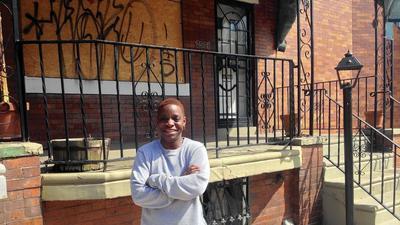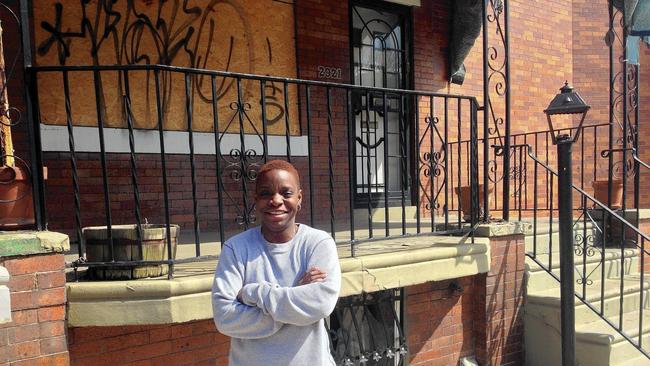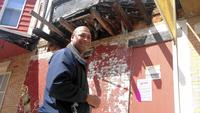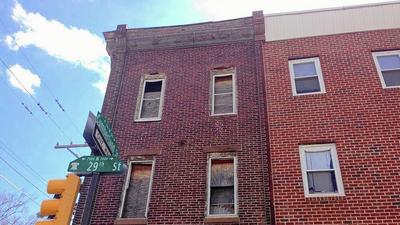| |
From Chief Chris Magnus:
Especially during tough budget times, it may be tempting for some to look at Code Enforcement efforts as an easy place to make major cutbacks, but as you can see from the article below, even cities much larger than Richmond are figuring out how critical code enforcement/blight abatement efforts are to rebuild property values, increase resident satisfaction with their neighborhoods, and help reduce crime. Richmond is way ahead of many cities with its Code Enforcement Unit, that is part of the Police Department. We are already using many of the strategies other cities are just starting to implement to reduce blight—with considerable success. This is a good article, which merits a quick read . . .
Chief Magnus
City of Brotherly Love finally tackles neighborhood blight

Enforcing Philly's ban on boarded-up doors and windows
Inspector Derrick McCall is part of a new strategy in Philadelphia to force abandoned property owners to install working doors and windows, or face fines of $300 per opening -- per day.
Inspector Derrick McCall is part of a new strategy in Philadelphia to force abandoned property owners to install working doors and windows, or face fines of $300 per opening -- per day.
Alana Semuels contact the reporter
NationLaws and LegislationPhiladelphia (Philadelphia, Pennsylvania)
Philadelphia goes after ramshackle properties
Philadelphia trying to "to preserve the neighborhoods of the people who aren't leaving"
Plywood on doors and windows?
Armed with a staple gun and a sheaf of bright pink posters, Derrick McCall is trying to stop this city's decline.
He drives his noisy city truck through North Philadelphia, looking for a house on 26th Street, one of the 25,000 vacant structures in the city. He finds it in a line of row houses, its front door and window sheathed in plywood.
McCall staples a poster to the plywood covering the door. The poster declares the building "a blighting influence," in violation of a city code that requires all buildings to have working doors and windows. Plywood or other boards are prohibited, and the fine is $300 per opening — per day.
After decades of ignoring the blight that has spread through its neighborhoods, Philadelphia is trying to reclaim its vacant homes through aggressive initiatives designed to compel negligent owners to fix their properties or see them seized and torn down.

Philadelphia battling blight
Alana Semuels / Los Angeles Times
When Alisha Smith moved into her North Philadelphia home, this nearby house was occupied. Now it is boarded up, which depresses property values and makes Smith worry for her safety.
When Alisha Smith moved into her North Philadelphia home, this nearby house was occupied. Now it is boarded up, which depresses property values and makes Smith worry for her safety. (Alana Semuels / Los Angeles Times)
In just a few short years, the city has made impressive progress; experts say some of the tools used in Philadelphia may help other post-industrial cities coping with decades-long population decline and the neglected space left behind.
On 26th Street, the house McCall tagged had been a source of complaint.
"I really hope they're going to do something about this place," neighbor James Culler calls out as McCall is leaving. "I had to redo my basement because of the water leaking in from there."
The door and window ordinance allows community groups to take over dilapidated properties and repair them. Another will establish a land bank for the city so it can begin to redistribute abandoned properties to people and groups who want to build something new.
Neighborhoods where the new strategies have been applied have seen home prices rise 31% over four years,compared with a 1% rise in comparable areas,according to a study by Ira Goldstein of the Reinvestment Fund. The initiatives increased home values by $74 million throughout Philadelphia, Goldstein said, and brought in $2.2 million more in transfer tax receipts.
Philadelphia had been spending millions of dollars a year to tear down vacant properties, and it didn't seem to be making much headway, said Rebecca Swanson, who directs the city's vacant building strategy. So in 2011, city officials decided to try a strategy they hoped would prevent properties from becoming run down in the first place.
The city utilized software used by the IRS to track down owners of the vacant buildings. Then the city took the owners to a newly created Blight Court. The door and window ordinance also allows the city to attach liens to property owners' other personal property, including, in some cases, mansions in the suburbs.

Philadelphia battling blight
Alana Semuels / Los Angeles Times
Building inspector Derrick McCall leaves a poster informing the property owner that the home violates Philadelphia codes.
Building inspector Derrick McCall leaves a poster informing the property owner that the home violates Philadelphia codes. (Alana Semuels / Los Angeles Times)
"That was the whole point, to catch them early, cite them for doors and windows, and hopefully that incentivizes the owner to come out of the woodwork and do something," Swanson said.
City inspectors have investigated 13,000 vacant properties, and cited 9,000 of them for violations, she said. Property tax collection has risen in those neighborhoods, and the city has collected more permits and licensing fees as property owners start to rehabilitate the homes.
Like many cities in the Northeast, Philadelphia has lost population since the 1950s. Factories that once employed thousands closed shop, and residents moved out, leaving behind empty homes. The city, which had 2 million residents at its peak, lost more than half a million people. Many remaining residents are older, and when they die, they often leave empty properties behind.
But the population has ticked up slightly in recent years — to 1.5 million — bolstering the city's efforts to put new people into once-empty dwellings. Swanson points to neighborhoods such as Francisville, just north of Center City, as proof that the strategy is working.
Driving through the area, she points to oddly shaped lots where once-vacant buildings have been razed. Rather than pay the fines, owners sold the buildings to developers, who tore them down to erect condos for residents who want to be close to public transit options. A bike shop has popped up nearby.
Part of Philadelphia's success has stemmed from statewide laws that allow cities to go after ramshackleproperties, said Liz Hersh, executive director of the Housing Alliance of Pennsylvania. After the housing crash, she said, cities got more interested in reclaiming the land that they already had, rather than spreading further out into empty space on the margins.

Philadelphia battling blight
Alana Semuels / Los Angeles Times
This home in North Philadelphia, with its boarded-up doors and windows, violates a code that the city recently began to enforce that fines owners $300 per opening per day.
This home in North Philadelphia, with its boarded-up doors and windows, violates a code that the city recently began to enforce that fines owners $300 per opening per day. (Alana Semuels / Los Angeles Times)
"Even if it's not going to be an up-and-coming neighborhood where you're building all these new houses, it's stabilizing and keeping the blight from spreading," Hersh said. "And I think that's what's really replicable in other cities that are still losing population, is to preserve the neighborhoods of the people who aren't leaving."
Richard Vanderslice is a Philadelphia real estate attorney who represents building owners who have been cited as well as community groups who want to take over blighted properties and rehabilitate them. He said that although landlords complain about the citations, they often end up spending the money to fix the windows and doors, and then decide to spend the extra money to make the properties habitable.
"They say, 'How do I fight this?' and I say, 'Fix it. It's going to cost you more to fight it, and by the way, why not just replace the door, rent it out and make some money from it?' And sometimes a light bulb goes off," he said.
There are many homes in Philadelphia that may be past saving.
They include the one next door to Albert Williams on a quiet block in North Philadelphia. The structure was badly burned in a fire years ago and left to rot. Now, a tree is growing through its burnt-out roof, and the eroding porch is punched with holes. Plywood covers the doors and windows. The city has already labeled it a dangerous building, posting an orange notice on the door warning people to keep out.
The building is one of nearly 600 in the city that have been declared dangerous and are targeted for demolition. But the city's annual budget for tearing down these homes is only $6 million.
"I've been calling and crying to no avail," Williams tells McCall, the building inspector, when he arrives outside the ruined building one recent afternoon, snapping photos.
McCall assures him that the door and window ordinance will force the owner to do something.
"It is in the system now," he says. "But it is a really slow process."
|
|

